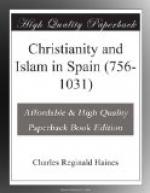The reception of Recared and his Court into the Catholic fold was the signal for an attempt to establish the papal authority, which was the more dangerous now, as the popes had gained a great increase of power since Spain was cut off from orthodox Christendom by the invasion of the Arian Goths.
One of Recared’s first acts was to write to the pope and, saluting him, ask him for his advice in spiritual matters. The papal authority thus acknowledged was soon exercised in—
(a.) Deciding ecclesiastical appeals without regard to the laws of the land;
(b.) Sending to Spain pontifical judges to hear such cases;
(c.) Sending legates to watch over the discipline of the Church;
(d.) Sending the pall to metropolitans.
These metropolitans, unknown in the earlier history of the Spanish Church, came gradually to be recognised, owing to the papal practice of sending letters to the chief bishops of the country. They became invested in consequence with certain important powers, such as those of convoking provincial councils; of consecrating suffragans; of holding ecclesiastical courts, and watching over the conduct of bishops.[1]
But though a certain authority over the Spanish Church was thus conceded to the pope, yet owing to the independent spirit of the Spanish kings and clergy, he contented himself with a very sparing use of his power. In two points, in especial, the claims of the pope were strenuously resisted.
(a.) The purchase of dispensations from Rome was expressly forbidden.
(b.) Papal infallibility was a dogma by no means admitted. Thus the prelates of Spain in the fifteenth and sixteenth councils of Toledo, defended the orthodoxy of their fellow-bishop, Julian, against the strictures of the then pope, Bendict II.; and Benedict’s successor, John V., confessed that they had been in the right.[2]
This spirit of opposition to the supremacy of the pope we find manifested to the last by the Spanish kings, and there is some reason for thinking that in the very year of the Saracen invasion the king, Witiza, held a synod, which emphatically forbade appeals to Rome.[3] One author even goes so far as to say that the Gothic king and his clergy being at variance with the pope, the latter encouraged and favoured the Saracen invasion.[4]
[1] Masdeu, xi. p. 167, ff., quoted by Dr Dunham.
[2] Dunham, i. p. 197.
[3] See Hardwicke’s
“Church in the Middle Ages,” p. 42.
He
quotes Gieselar, “Ch.
Hist.,” iii-132.
[4] J.S. Semler, quoted by Mosheim, ii. 120, note.




